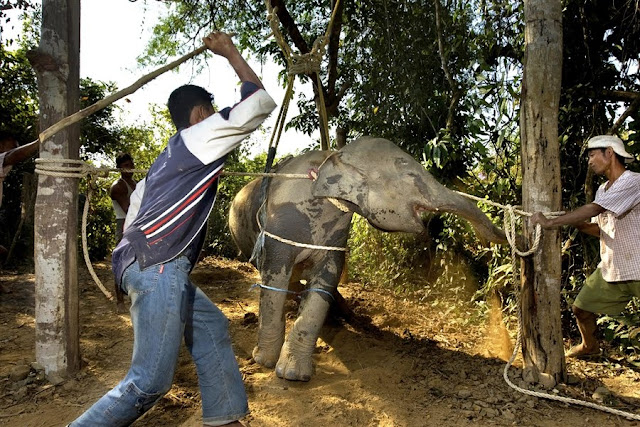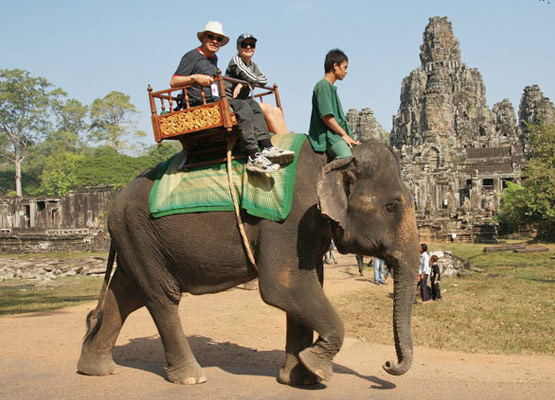Why You Should Never Ride an Elephant
WARNING: There are upsetting images in this post
Now I must admit, although I knew elephant riding wasn't ethical before coming to Asia, it is since being out here and visiting an amazing elephant sanctuary, I have learnt all about what these beautiful animals go through when under the ownership of riding companies and circuses etc. I am not doing this post to be preachy, in fact I wasn't even planning on doing it at all, but I know a lot of people are unaware of the unfair life of an elephant forced to work in the tourism industry and this information needs to be shared.
 |
| Elephant riding at Angkor Wat, 3 people per elephant (one being a large man) |
I am sad to say our recent trip to Angkor Wat was completely ruined for me when I saw the elephant rides being sold there. We had just sat down to eat our lunch, when one by one, about 6-7 elephants walked past us with their Mahout (trainer) on their heads. They stopped at a little fenced off area where they are made to stand still and wait until paying tourists climb up the steps and jump on the saddles on their backs. The sight of these poorly treated, depressed elephants caused me to burst into tears instantly, knowing the torture inflicted upon them for their owners to make a buck.
This isn't going to be a nice post to read, but it is an important one. Once you have read this, I ask you to please share the information on to people who are still unaware of why elephant riding is a terrible thing. The mistreatment of these animals only continues to happen because unknowing tourists continue to put their money into these businesses, if everyone knew the damage they are causing and boycotted elephant products, these animals would be able to live in peace.
 |
| Again at Angkor Wat, 6 people on one elephant. Look at the animal's ripped ears and scared eyes |
Before
A wild elephant will not just let someone jump on it's back, therefore it needs to be trained before being allowed near tourists and used for rides. The chosen method for 'breaking' is by kidnapping a baby elephant from it's mother and torturing it to break it's spirit and create a fear of humans. This process is called the 'Phajaan' and involves tying the baby tightly to tree trunks so it is unable to move. They are then beaten with clubs and bull hooks, starved, deprived of sleep and often forced to continuously walk around one tree trunk to learn how to follow a route. It is important for the people carrying out the Phajaan to tie the elephant's trunk away from its feet, otherwise the distressed animal may try to step on it to low the airflow, a suicide attempt.
 |
| Real photos of the crushing Phajaan process |
During
Elephants may be the largest land mammal, however their backs are not made to support the weight of us humans, let alone the huge saddles used by riding camps. I couldn't imagine having to carry around my 10kg travelling backpack for even an hour, these elephants work all day everyday. In Angkor Wat for example, first elephant rides start at 8am and the last ones finish at 10.30pm. The day we visited was above 30 degrees Celsius, we could only manage to walk around for 4 hours before the heat was unbearable, and that was without any extra weight. Last year, an old female elephant named Sambo died from dehydration and exhaustion there, she never retired, never saw a day of freedom.
 |
| Sambo the elephant died last year at Angkor Wat from dehydration and exhaustion |
The continued use of the saddle causes the spines of these elephants to become permanently damaged and slant downwards. It also rubs against the skin causing blisters that get infected and the same goes for the animals feet from extensive trekking.
 |
| Natural tall curved backs of Asian elephants |
 |
| An extreme case of a broken back and dislocated hips |
 |
| This is an elephant we met at the Elephant Nature Park, you can see her slanted back and dislocated hip |
The Mahout's I witnessed at Angkor Wat, were directing the elephants by kicking the top of their ears, however other methods include digging a pin or sharpened fingernail into the ears or elbows.
An elephant's nature is to be amongst the quiet jungle with their trusted members of the herd. However, when they are riding with tourists, they can be made to walk along roads with cars which may drive past too quickly or honk their horn, resulting in scaring the animal. Circus elephants are made to perform alongside loud music, bright blinding lights, applause, fire etc. all of which is extremely distressing to them. If the elephants becomes scared, it's Mahout will act in striking the creature with a bull hook to the head, instructing it to carry on as normal.
 |
 |
| Bright lights, loud noises and a large audience could all scare an elephant |
 |
| A baby elephant learning circus tricks |
After
If an elephant has for some reason become unable to perform/trek for tourists, perhaps due to a permeant injury, the owners will need to find different ways to make money out of it. If the elephant is female, a common one is breeding.
In the wild, a female elephant chooses her male partner and initiates the mating, allowing it to happen. Whereas, when the owners want their elephant to breed for money, she will be tied down and a male elephant forced upon her. If she is forced upon too many times serious damage can be caused, leaving the elephant not only infertile but also unable to control her own bodily functions as parts of her sexual organs have been broken.
 |
| A female elephant being held down, having the much larger and aggressive male forced upon her |
Some elephants are forcibly taught to paint by having a paintbrush shoved into their trunk (which they use to breathe), and a Mahout's sharpened nailed pressed into their delicate, sensitive ears to direct them. Most paintings are very basic and similar and are sold to tourists.
 |
 |
| The elephant's ear is pulled and pinched so they obey commands |
Another act of desperation for money is to sell the elephant's hair. Owners will cut off everything from the tail hair to the animal's eyelashes to make bracelets to sell to tourists. Leaving an elephant without tail hair means it is unable to bat away any unwanted bugs that suck their blood and bury themselves in the elephant's skin to lay their eggs, leaving them with painful sores. Without eyelashes, dirt and sand can easily enter the eye and lead to infections causing blindness.
Everything I have written in this post is 100% true. This is how elephants are treated for tourism in Asia, they are not allowed any time to be animals, they are abused constantly for their whole lives. I would like to stress to anybody planning to visit Asia, that any business can deem itself a 'sanctuary' because they know that is what tourists want to hear, anywhere that offers elephant rides is NOT ethical. For example, this is how Angkor Wat advertise their rides by describing the respect Cambodians have for elephants and stating they wish to teach people how to preserve and sustain them.
 |
| http://www.angkorfocus.com/siem-reap-attractions/angkor-elephant-rides.html |
Visiting a sanctuary is unlike anything else. They rescue elephants from their terrible pasts and allow them to just be animals, it is more expensive but it will be an experience 100% better for both you and the elephants. If you are ever paying for any animal experience as a tourist please step back and think about whether it is natural or if the animal is being mistreated for human entertainment.
 |
| Happy elephants, rescued from abuse and living at the Elephant Nature Park sanctuary |
My next post will be a happier elephant post about our amazing stay at the Elephant Nature Park, Chiang Mai.
Please, please, PLEASE share this information with people you know and even people you don't know. If you hear somebody is planning on elephant riding or see pictures that they have, stand up for these intelligent, beautiful, endangered species. They can't stand up for themselves, only we can stop their misery.
Thank you,
Lon x










This is such an important subject. Well done for raising awareness! xxx
ReplyDeleteThanks so much hun xxx
Delete